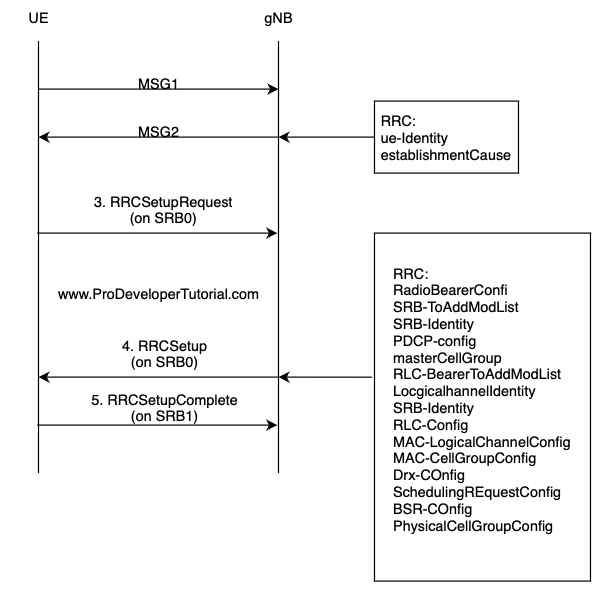Cell Search and Cell Selection
1. When a UE is powered on, it searches for a specific frequency according to Synchronization Raster as defined in TS 38.104.
2. UE tries to detect PSS/SSS to get downlink synchronization and get the PCI of the cell.
3. UE attempts to read MIB and obtain SSB information, SFN and time frequency domain information of SIB1.
4. UE reads SIB1, obtains uplink initial BWP info, info for configuring initial BWP, semi-static config of TDD, and get the search space information of the broadcasted OSI.
SSB = PSS + SSS + PBCH
System Broadcast Messages
System broadcast messages are needed to know the basic network information.
They are divided into MSI (Minimum System Information) and OSI (Other System Information).
MSI: MIB and SIB1.
OSI: SIB2-SIB9
MSI provides the most basic initial access information (SFN, carrier spacing, SSB offset) including cell barring and basic physical information required to receive further system information.
Below are the information required for initial access:
1. Cell selection information
2. Cell access information (PLMN, TAC, CellID)
3. SI scheduling information (SI cycle , window length, SIB mapping, etc.)
4. Cell configuration information (frequency band, frequency point, bandwidth, initial BWP configuration, etc.)
Cell Search – Synchronisation Signal
System information will be broadcasted periodically or on demand.
UE obtains system information in below reasons:
1. To searching for a cell and to parse the MIB and check the cell status, if it is barred, then cell will stop the system message acquisition.
2. Then use the parameters carried in MIB and parse SIB1.
3. Then if the other SIB are periodic broadcast, then parse the SI according to he OSI search space from SIB1.
Random Access Procedure
UE performs cell access procedure for downlink synchronization.
UE performs Random Access procedure for uplink synchronization.
Random Access procedure is divided into 2 parts.
1. Contention-based random access (CBRA)
2. Non-contention-based random access (CFRA)
Read previous chapters on when UE triggers CBRA and CFRA.
RRC Connection Establishment Procedure
1. UE initiates Competitive Random Access
2. gNB sends MSG2.
3. UE -> NW: UE sends RRCSetupRequest message to gNB. This is MSG3.
4. NW -> UE: gNB allocates and establish SRB1 bearer for UE and sends RRCSetup to UE.
5. UE sends RRCSetupComplete message.
Registration Procedure
1. UE selects a random access code from ZC sequence. That is called as Random Access Preamble ID (RAPID).
2. gNB will allocate temporary RNTI to the UE.
3. UE will use RA-RNTI to descramble DCI 1_0 PDCCH to get the RAR information.
4. UE decodes RAR and obtain the UL Grant.
5. UE sends MSG3 using the UL grant information
6. gNB uses TC-RNTI to scramble PDCCH in DCI 1_0 to UE.
7. UE decodes RRCSetup message and gets the information. If the decoding is not OK, then it has to start RACH procedure again.
8. UE will send RRCSetupComplete message to gNB.
9. gNB sends AS layer encryption and integrity protection algorithms to UE.
10. UE applies the algorithms and sends confirmation to gNB.
11. gNB sends RRCReconfiguration message to UE.
12. UE replies with RRCCReconfiguration Complete.
13. gNB allocates the corresponding TEID for UPF to send downlink data.
14. gNB sends the initial context setup response to AMF.
15. Sends a Registration Complete message to AMF.
